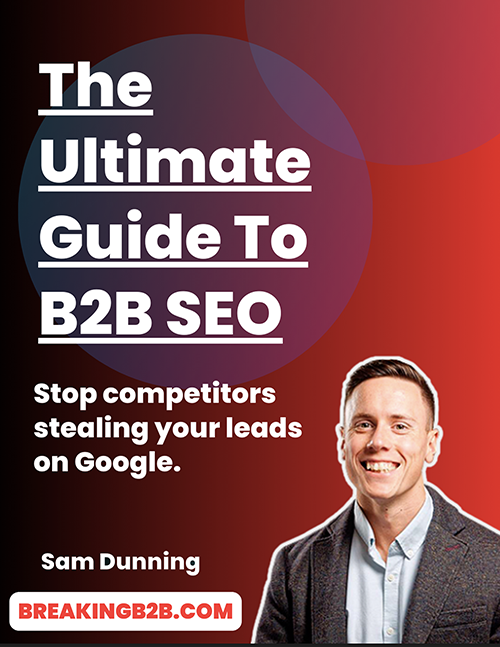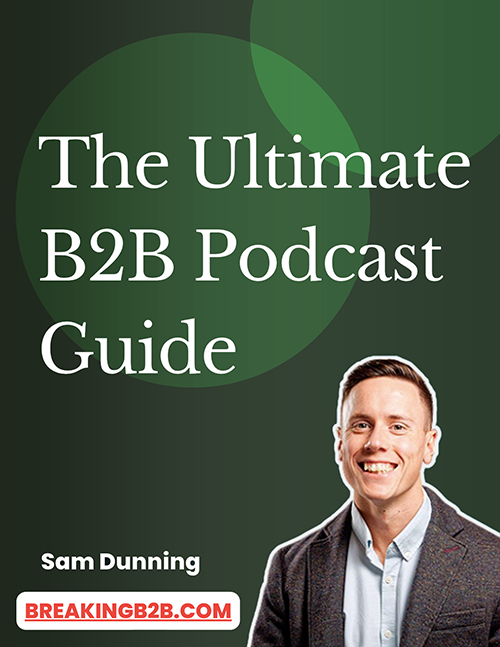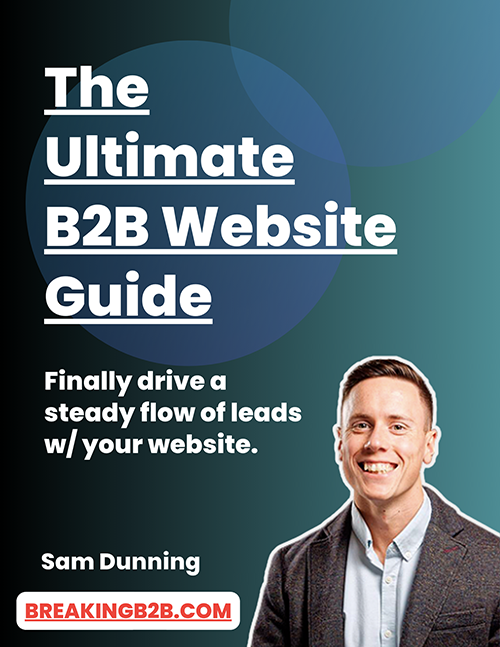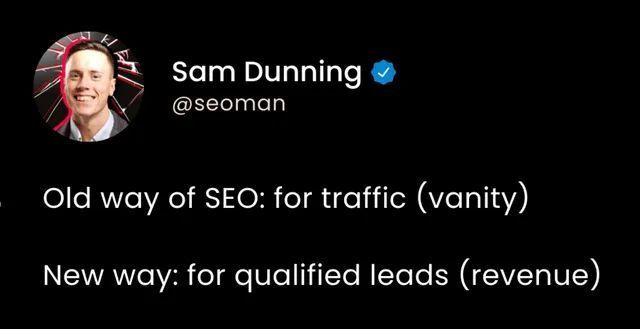13 SaaS SEO Trends
Staying Ahead of the Curve!
Author: Sam Dunning ✪ Date: June 22nd 2024
Software as a Service (SaaS) companies are constantly vying for visibility and customer acquisition. The secret weapon? Mastering SEO. As the backbone of online marketing, SEO is pivotal for SaaS businesses looking to enhance their online presence and outshine competitors. However, SEO is not static; it constantly changes and is influenced by algorithm updates, user behaviour shifts, & emerging technologies. In this detailed guide, we will discuss the latest SaaS SEO trends to keep you one step ahead!
What is SaaS SEO?
SaaS SEO is the process of optimising your Software as a Service website to improve its online visibility and attract high-quality traffic. As a SaaS company, you need to focus on search engine optimisation tailored specifically to your industry.
Effective SaaS SEO strategies can greatly boost your organic search traffic. When you optimise your website, you increase your chances of appearing in relevant search results, thereby driving more qualified leads to your site.
The goal is to make sure that when users search for solutions to their problems, your SaaS product is among the top options they see.
Here are SaaS SEO trends that will boost your digital strategy:
1. Non-branded Keywords
Targeting non-branded keywords allows your company to reach a broader audience and attract potential customers who aren't yet familiar with your brand. By focusing on search terms that address user pain points and industry topics, you can tap into a vast pool of organic traffic.
These keywords provide valuable insights into what your potential customers are searching for, enabling you to create solution-oriented content that meets their needs.
Including non-branded keywords in your SEO strategy diversifies your website's traffic sources and reduces dependency on branded searches.Neglecting non-branded keyword opportunities can limit your growth and hinder your ability to attract new users.
Also, non-branded keywords help you understand user search behaviour better. This understanding allows you to optimise your content around your audience's specific problems and challenges.
By addressing these pain points with relevant, helpful content, you position your brand as a trusted resource, increasing the likelihood of converting visitors into customers.
2. Voice Search Optimisation
To stay ahead of the curve, you'll need to optimise your content for voice search by focusing on natural language and user intent. Voice search is rapidly growing and already accounts for a significant number of all searches.This shift means your SEO strategy must adapt to how people naturally speak when using voice assistants.
Start by incorporating long-tail keywords into your content. Voice search queries are typically longer and more conversational than typed searches.
For example, instead of targeting 'best CRM software,' you might focus on 'what's the best CRM software for small businesses?' This approach aligns with how users phrase their questions.Understanding user intent is essential.
Voice search users often seek direct answers to specific questions. Optimise your content to provide clear, concise answers.Adopt a conversational tone in your writing. Mimic the way people speak to make your content more relatable and easier for voice assistants to interpret.
3. AI in SEO
AI's role in SEO has drastically transformed how we approach content creation and optimisation. With generative AI, you can quickly produce a vast amount of SEO content, saving time and resources.
However, remember that while AI-generated content is efficient, it often lacks the human touch necessary for deep audience engagement. Striking a balance between AI content and thought leadership will be essential.
The impact of AI on SEO extends beyond content creation. Engagement platforms like Instagram Reels are becoming important for driving traffic and user interaction. Leveraging AI to analyse engagement metrics on these platforms can help you fine-tune your content strategy and maximise reach.
AI can assist in optimising your content for voice search by identifying natural language patterns and predicting user intent. This ensures your content isn't only searchable but also relevant to voice queries.
Incorporating AI in your SEO strategy means you can stay ahead of trends and adapt quickly to changes in user behaviour. Combining generative AI with human insight will create more engaging and effective SEO content.
4. Omnichannel SEO
Imagine your SaaS SEO efforts as a symphony, where each instrument—be it social media, email marketing, or PPC—plays in harmony to create a melodic masterpiece. That's the essence of omnichannel SEO: integrating your search engine optimisation across various channels to craft a cohesive and powerful strategy.
Gone are the days when SEO was confined to just optimising your website. Today, potential customers interact with brands on multiple platforms.
By weaving SEO into social media posts, email campaigns, and even paid ads, you're ensuring a consistent message and experience, no matter where your audience encounters your brand.
For instance, a keyword-optimised blog post promoted via a targeted email campaign and shared across social media amplifies your reach and reinforces your message.
The beauty of omnichannel SEO lies in its holistic approach. It enhances visibility and builds trust and engagement. When customers see a unified brand presence, they're more likely to convert, knowing they're dealing with a credible and consistent entity.
5. Mobile-First Indexing
Google's shift to mobile-first indexing means your website's mobile version is now the primary focus for indexing and ranking. This change emphasises the importance of mobile-friendly websites for SEO success. With over half of global internet traffic coming from mobile devices, you can't afford to overlook this trend.
To guarantee your site excels in mobile-first indexing, prioritise responsive design. A responsive design adapts your website's layout to fit various screen sizes, providing a seamless user experience across all devices.
Additionally, fast loading speeds are essential. Mobile users expect quick access to information, and slow-loading pages can lead to higher bounce rates and lower rankings.
Moreover, make sure your website is user-friendly on mobile. This involves simplifying navigation, using readable fonts, and ensuring interactive elements like buttons and forms are easily accessible.
Google's mobile-first indexing is here to stay, and optimising your site accordingly will enhance your SEO success.
6. Original Content Creation
This not only improves your search engine rankings but also fosters stronger connections with your audience. What’s more, unique content is more likely to be shared, increasing your reach organically and driving more traffic to your site.
7. Local SEO
To enhance your local search visibility, optimise your Google My Business profile. This is a surefire way to boost your marketing efforts since 58% of businesses don’t optimise for local search. Ensure your profile is complete and accurate, including up-to-date contact details and business hours.
Responding to reviews can increase your local SEO ranking by up to 7%, so engage with your customers and encourage them to leave positive reviews. These reviews can boost your trust and credibility by 73%.
Creating localised content tailored to your target audience can result in a 14% increase in website traffic from local searches.
Use keywords relevant to your area, such as city names and local landmarks, to make your content more discoverable. Additionally, including your business address in meta descriptions can boost local pack rankings by 11%.
8. Backlink Building
Backlink building is among the top SaaS SEO trends. When you acquire backlinks from reputable sources, they act as endorsements, boosting your site's credibility and trustworthiness.
High-quality backlinks can greatly elevate your online visibility, making it easier for potential customers to find you in search results.Here are the benefits of backlink building:
- Increased Trust: Backlinks from well-known sites make users feel more secure about your content.
- Higher Rankings: Quality backlinks can propel your site higher in search engine results, driving more traffic.
- Broader Reach: A diverse backlink profile helps you tap into different audiences, expanding your market.
Building a diverse backlink profile is essential. It signals to search engines that your content is valuable across different contexts and platforms, further improving your rankings.
While it might seem challenging to secure high-quality backlinks, the effort pays off by significantly enhancing your website authority. Focus on creating exceptional, shareable content and reaching out to reputable sites in your industry.
9. Optimising for SGE
Optimising for Search Generative Experience (SGE) is an excellent technique for SaaS businesses that want to stay ahead of the competition. SGE leverages advanced AI to provide more interactive and personalised search results.
Imagine your potential customers interacting with AI-driven search results that answer their queries and engage them in meaningful dialogue. This is where SGE optimisation comes into play.
By optimising for SGE, SaaS companies can ensure their content is visible, engaging, and highly relevant. This involves creating high-quality, conversational content that addresses user intent with precision.
Think of it as holding a conversation with your audience, offering solutions and insights in a way that feels natural and intuitive.
Furthermore, SGE prioritises rich snippets, video content, and interactive elements, making it essential to diversify your content strategy. Integrating multimedia and leveraging structured data can significantly enhance your visibility in SGE results.
In a nutshell, optimising for SGE is about offering a seamless and engaging user experience that attracts and retains customers. It's an exciting time for SaaS SEO, and those who embrace SGE will undoubtedly lead the pack.
For more in-depth optimisation advice checkout my > SaaS SEO Technical Guide
10. Regular Website Audits
Regular website audits are vital to ensure your SaaS business stays competitive in search rankings. By performing these audits, you can identify and fix technical issues that might otherwise go unnoticed, severely hindering your SEO performance.
Given that only 5.7% of pages rank in the top 10 search results, monitoring your site's health is essential.Website audits help you spot issues like broken links, slow page speeds, and duplicate content, which can negatively impact user experience and search engine rankings.
Addressing these technical problems promptly ensures that your site remains optimised and user-friendly.
Another critical aspect of website audits is managing keyword cannibalisation. When multiple pages target the same keyword, it confuses search engines and dilutes your SEO efforts. Regular audits allow you to identify and correct these instances, ensuring each page targets a unique keyword. This strategy improves your site's clarity and enhances its overall SEO performance.
Incorporating regular website audits into your routine helps maintain your site's health and ensures you're always on top of potential issues.
11. E-E-A-T Guidelines
One of the hottest SEO trends right now is adhering to Google's E-E-A-T guidelines. E-E-A-T stands for Experience, Expertise, Authoritativeness, and Trustworthiness, and it's becoming the gold standard for content quality. Why is this so important for SaaS companies?
Firstly, SaaS businesses thrive on credibility. Potential customers are making significant commitments when they choose a software provider, so they need to trust that the company is an expert in its field.
By showcasing experience and expertise in your content, you not only improve your rankings but also build a stronger rapport with your audience. Think comprehensive how-to guides, case studies, and expert insights that demonstrate deep knowledge and practical experience.
Authoritativeness is equally critical. Google favours content that comes from recognised sources, and for a SaaS company, this means leveraging thought leadership. Publish articles that contribute to industry conversations, get featured in reputable publications, and encourage user-generated content like reviews and testimonials.
Trustworthiness ties it all together. In an industry where data security and reliability are paramount, demonstrating trustworthiness can set you apart. This can be achieved through transparent privacy policies, customer success stories, and responsive customer service.
Following Google's E-E-A-T guidelines boosts your SEO performance and fortifies your brand's reputation. It's not just a trend; it's a strategic approach to building a sustainable and respected presence in the crowded SaaS market.
12. LinkedIn SEO
As a professional networking powerhouse with over a billion members worldwide, LinkedIn offers unparalleled opportunities for SaaS companies to connect with potential clients, partners, and industry influencers.
Mastering LinkedIn SEO can propel your SaaS business to new heights. Here are some reasons why LinkedIn SEO Matters for SaaS Companies:
- Professional Audience: LinkedIn's user base comprises decision-makers, professionals, and industry leaders, making it an ideal platform for B2B SaaS companies to showcase their expertise and solutions.
- High Search Engine Authority: LinkedIn profiles and posts often rank highly on search engines, enhancing your company's visibility beyond the platform itself.
- Content Distribution: LinkedIn allows for the distribution of valuable content, helping to establish thought leadership and drive organic traffic to your website.
Tips for Optimising LinkedIn SaaS SEO
Here are seven actionable tips to enhance your LinkedIn SEO:
- Craft a Compelling Company Profile
Your company profile is your first impression. Use a high-quality logo, create a captivating cover image, and write an engaging company description. Incorporate specific keywords that reflect your SaaS solutions to improve search-ability. - Leverage Keywords Strategically
Identify and incorporate relevant keywords throughout your profile. This includes your tagline, about section, and even job titles. Keywords like "cloud-based software," "B2B solutions," and "[specific industry] SaaS" can help attract the right audience. - Optimise Content for Engagement
Regularly post content that provides value, such as industry insights, case studies, and how-to guides. Engaging content encourages likes, comments, and shares, which signal LinkedIn's algorithm to boost your visibility. - Encourage Employee Advocacy
Your employees can be your biggest brand ambassadors. Encourage them to share company posts and updates. When employees engage with your content, it expands your reach to their networks, enhancing your SEO. - Utilise LinkedIn Articles
Publishing long-form articles on LinkedIn positions your company as a thought leader. Articles are indexed by search engines, providing an additional avenue for organic traffic. Focus on topics that address common pain points in your industry. - Join and Participate in Groups
LinkedIn groups relevant to your industry are gold mines for engagement. Actively participating in discussions and sharing insights can drive traffic back to your company page, improving its SEO. - Analyse and Adjust
Review LinkedIn analytics regularly to understand which content resonates most with your audience. Use these insights to refine your strategy, ensuring continuous improvement in your LinkedIn SEO efforts.
By embracing LinkedIn SEO, SaaS companies can enhance their digital footprint, foster meaningful connections, and drive growth in a competitive market. Make LinkedIn an integral part of your SEO strategy and watch your SaaS business thrive.
If you've not yet had a look, checkout my > SaaS SEO Checklist
13. Conversion Tracking
Conversion tracking lets you understand how your website traffic translates into user behaviour that matters, like sign-ups or purchases. By analysing these conversions, you can gain insights for further optimisation and better ROI assessment.
To get started, implement conversion tracking tools like Google Analytics. These tools will help you monitor user interactions and understand how visitors navigate through your site. You'll be able to see which keywords and content drive the most conversions, allowing you to fine-tune your strategy.
Consider these benefits of effective conversion tracking:
- Informed Decisions: You'll gain invaluable insights into user behaviour, helping you make data-driven choices.
- Enhanced Performance: You can improve overall site performance by identifying and optimising weak points in your conversion funnel.
- Increased ROI: Clearly attributing SEO efforts to revenue makes it easier to justify and allocate resources.
With a solid conversion tracking system in place, you can continuously refine your approach. This ensures that your SEO efforts aren't just driving traffic but also achieving meaningful results for your SaaS business.
These SaaS SEO trends will help you boost your company’s visibility and increase revenue.Remember, SEO is not a one-time effort but an ongoing journey of refinement and innovation. So, stay curious and proactive, and you’ll see your business thrive.
If these 13 trends have left you hungry for more expert advice, head on over to my > Ultimate B2B SaaS SEO Guide
SaaS SEO Trends Frequently Asked Questions (FAQs)
Ready To Grow Your B2B Company?







